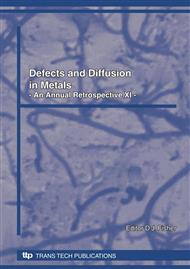p.53
p.63
p.67
p.71
p.77
p.83
p.91
p.99
p.107
Chemical Precipitation Synthesis and Magnetic Properties of Hematite Nanorods
Abstract:
One-dimensional (1D) hematite (α-Fe2O3) nanorods have been successfully prepared using a chemical precipitation method. The sample was characterized by using a variety of techniques, such as X-ray diffraction (XRD), transmission electron microscopy (TEM) and vibrating sample magnetometry (VSM). The results showed that the nanorods obtained were monocrystalline, with an average diameter of about 60nm and a length of up to 800nm. In the preparation of α-Fe2O3, the length of α-Fe2O3 seemed to increase with the addition of polyethylene glycol (PEG), and the diameter seemed to decrease with the addition of Zn2+. Nanorods of α-Fe2O3 with a smaller diameter and superior slenderness ratio were prepared by adding both PEG and Zn2+. A possible growth mechanism effect of PEG and Zn2+ upon the morphology of α-Fe2O3 was as follows: α-FeOOH grew in a one-dimensioned orientation upon the surface of a polyethylene glycol template. In the meantime, the Fe3+ position in the α-FeOOH crystal was substituted by Zn2+; resulting in point defects in α-FeOOH crystal due to the radius discrepancy between Zn2+ and Fe3+. The growth-step energy was then reduced as a result of the point defects in the α-FeOOH crystal. The results of magnetic measurements of the hematite nanorods revealed a weak ferromagnetic property which might be related to the shape anisotropy.
Info:
Periodical:
Pages:
77-82
Citation:
Online since:
August 2009
Authors:
Keywords:
Price:
Сopyright:
© 2009 Trans Tech Publications Ltd. All Rights Reserved
Share:
Citation:


